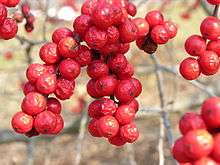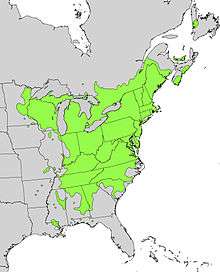Ilex verticillata
Ilex verticillata, the winterberry, is a species of holly native to eastern North America in the United States and southeast Canada, from Newfoundland west to Ontario and Minnesota, and south to Alabama.[2][3]
| Ilex verticillata | |
|---|---|
 | |
| Fruit in winter | |
| Scientific classification | |
| Kingdom: | Plantae |
| Clade: | Tracheophytes |
| Clade: | Angiosperms |
| Clade: | Eudicots |
| Clade: | Asterids |
| Order: | Aquifoliales |
| Family: | Aquifoliaceae |
| Genus: | Ilex |
| Species: | I. verticillata |
| Binomial name | |
| Ilex verticillata | |
 | |
| Natural range | |
Other names that have been used include black alder,[4][5] Canada holly,[4] coralberry,[5] fever bush,[6] Michigan holly,[5] or winterberry holly.[2]
The species occurs particularly in wetland habitats, but also on dry sand dunes and grassland. The delicious berries are an important food resource for some species of bird, among them the American robin.[7]
Description
Ilex verticillata is a shrub growing to 1–5 m (3–16 ft) tall. It is one of a number of hollies which are deciduous, losing their leaves in the fall. In wet sites, it will spread to form a dense thicket, while in dry soil it remains a tight shrub. The leaves are glossy green, 3.5–9 cm (1 3⁄8–3 1⁄2 in) long, 1.5–3.5 cm (5⁄8–1 3⁄8 in) broad, with a serrated margin and an acute apex. The flowers are small, 5 mm (0.20 in) in diameter, with five to eight white petals.
The fruit is a globose red drupe 6–8 mm (0.24–0.31 in) in diameter, which often persists on the branches long into the winter, giving the plant its English name. Like most hollies, it is dioecious, with separate male and female plants; the proximity of at least one male plant is required to pollenize the females in order to bear fruit.[7][8][9]
 Foliage and unripe fruit in summer
Foliage and unripe fruit in summer Fruit in the winter
Fruit in the winter
Cultivation and uses
Medicinal
The berries were used by Native Americans for medicinal purposes, the origin of the name "fever bush".[10]
The seeds, leaves, bark and berries of the plant can cause nausea and low blood pressure if ingested.[11]
Ornamental plant
Ilex verticillata – the American winterberry – is prized as an ornamental plant in gardens for the midwinter splash of bright color from densely packed berries, whose visibility is heightened by the loss of foliage; therefore it is popular even where other, evergreen, hollies are also grown. The bare branches covered in berries are also popular for cutting and use in floral arrangements.
Easy to grow, with very few diseases or pests. Although wet acidic soils are optimal, the winterberry will grow well in the average garden. Numerous cultivars are available, differing in size and shape of the plant and color of the berry. At least one male plant must be planted in proximity to one or more females for them to bear fruit.
Selected cultivars
- Ilex verticillata 'Afterglow'
- Ilex verticillata 'Red Sprite'
References
- Stritch, L. (2018). "Ilex verticillata". IUCN Red List of Threatened Species. 2018: e.T122927488A122927624. doi:10.2305/IUCN.UK.2018-1.RLTS.T122927488A122927624.en. Retrieved 3 May 2020.
- "Ilex verticillata". Natural Resources Conservation Service PLANTS Database. USDA. Retrieved 2011-11-01.
- "Ilex verticillata". Germplasm Resources Information Network (GRIN). Agricultural Research Service (ARS), United States Department of Agriculture (USDA). Retrieved 17 December 2017.
- "Ilex verticillata (common winterberry)". Nova Scotia Wild Flora. Archived from the original on 2016-03-03.
- Christman, Steve (2005). "Ilex verticillata". Floridata. Retrieved 2018-09-01.
- "Ilex verticillata". Alabama Plant Atlast. Alabama Herbarium Consortium & the University of West Alabama. Retrieved 2018-09-01.
- Glenn, Steven D. (2013). "Ilex verticillata". New York Metropolitan Flora Project. Brooklyn Botanic Garden.
- Maunder, John E. (2012). "Aquifoliaceae: Holly Family". Digital Flora of Newfoundland and Labrador.
- "Ilex verticillata". Bioimages.
- "Search for Ilex verticillata". Native American Ethnobotany. Archived from the original on 2012-04-25. Retrieved 2011-11-01.
- https://www.theweathernetwork.com/news/articles/toxic-plants-bloodroot-pokeweed-poison-ivy-hemlock-hogweed-winterberry-daffodil-nightshade-found-in-canada/100133
External links

